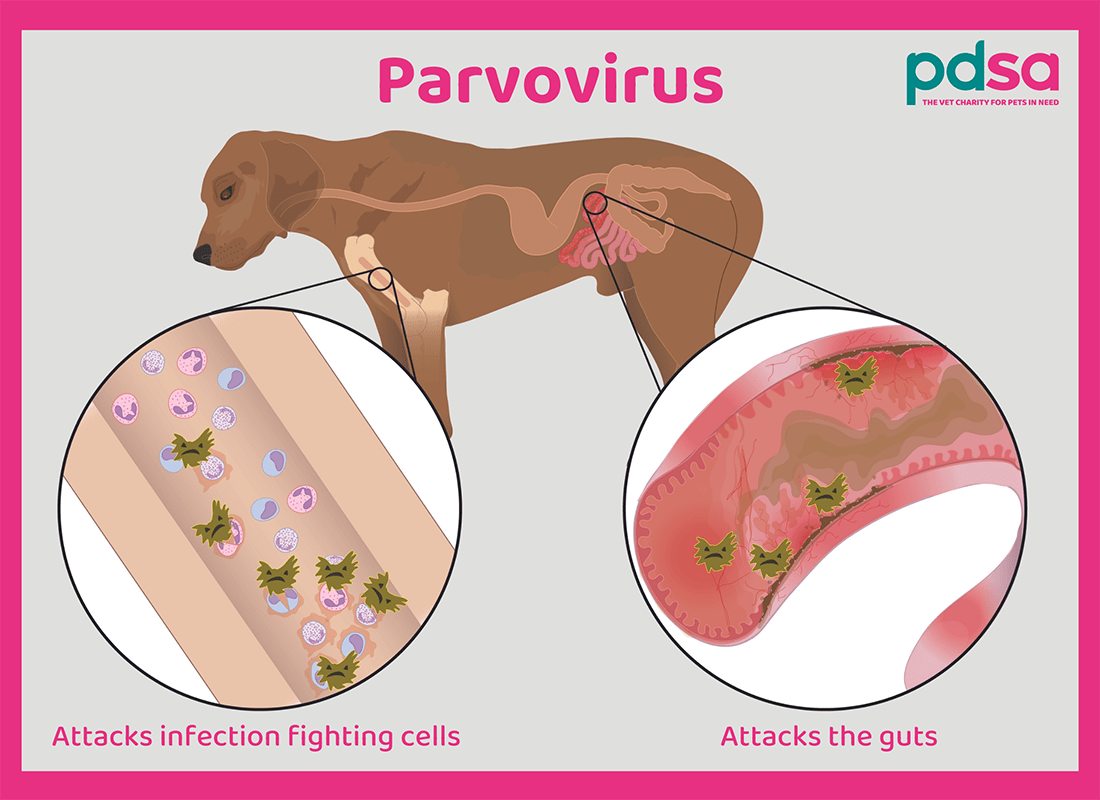
CPV Attacks Body // PDS
TOTAL DAMAGE. CPV invades cells like lymphocytes, bone marrow cells and epithelial cells. This results in dehydration, nausea and severe diarrhea.
 CPV // PDSIT LIVES ON. CPV will still be in the environment even if the injected feces is removed.
CPV // PDSIT LIVES ON. CPV will still be in the environment even if the injected feces is removed.
By: Ashley Bergeron
Staff Writer
We’re nearing the holidays, which is a time of year where animal adoptions spike. If you’re considering bringing home a furry friend, it’s important to be armed with information to keep them safe and healthy. Welcome to That’s Zoo Sick, where we’ll discuss illnesses affecting animals and how you can keep your pets safe.
Canine Parvovirus (CPV or Parvo) is a DNA virus that is very contagious and extremely fatal if left untreated.
Puppies and unvaccinated dogs are the greatest risk, which is why it is important to keep your dogs up to date on their vaccinations. Rottweilers, Doberman Pinscher, German Shepherds, American Pit Bull Terriers and English Springer Spaniels are at a higher risk of getting CPV than other breeds.
Symptoms of CPV include lethargy, loss of appetite, vomiting, severe or bloody diarrhea, abdominal pain and bloating, and fever or hypothermia. If you notice any of these symptoms, go to your veterinarian or an emergency vet immediately.
Dogs can get Parvo from interacting with infected dogs, infected feces or contaminated areas. CPV can survive in environments for a long time (months to years) and is resistant to heat, cold, humidity and dry conditions. If you think your dog has died due to CPV, don’t bury them in the ground; it could cause other dogs to contract the virus.
Parvo treatment is determined by a vet and depends on the severity of symptoms. Some treatments include hospitalization and monitoring, fluids to combat dehydration, antibodies, medication to help with nausea and vomiting and blood transfusions to help with low white blood cell count. However, there isn’t a cure for CPV, and some dogs might die despite receiving treatment.
The average cost of treatment for CPV is $1,000-$2,100 and can be higher, while the average CPV vaccine cost is $30-$50. It is both more cost effective and more humane to keep your dog updated on their vaccines to prevent them from suffering.
How does it work?
CPV first appeared in Europe in 1976 and became a global epidemic in 1978. It is suspected to be a mutation of Feline Panleukopenia Virus (FPV).
Before symptoms start to show, there is an incubation period where CPV attacks the tonsils or lymph nodes. They invade lymphocytes (a type of white cell) and make multiple copies of themselves, and they can then enter the bloodstream without being attacked by the dog’s immune system.
CPV primarily targets a dog’s bone marrow and small intestine. If the dog is very young, CPV will also attack heart cells, resulting in heart inflammation and improper functioning.
When CPV attacks the lining of the small intestine, called the epithelium, it prevents the dog’s body from creating new cells, causing the epithelium to lose its function. This causes the gastrointestinal symptoms listed above, and severe damage causes gut bacteria to enter the dog’s bloodstream, which can be very dangerous when the dog’s immune system is already weakened by the virus.
How can I prevent it?
The best way to prevent CPV is to vaccinate your dogs as soon as you can. If you think your home has been contaminated, clean it with a bleach solution (one part bleach and thirty parts water). However, if you think your yard has been contaminated, DO NOT use bleach outside. Rainwater will dilute the concentration of the virus over time, so it’s best to make sure your dogs are up to date on their vaccines and that no unvaccinated dog goes into your yard.
If you have any questions about CPV, contact your veterinarian (or any local veterinarian if you don’t currently have one) and they will be happy to help.